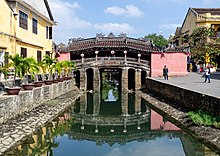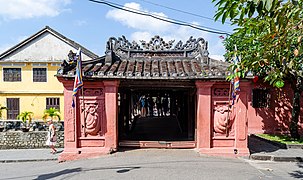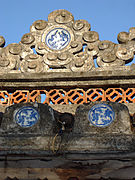Chùa Cầu
Chùa Cầu (also: Japanese Bridge , Vietnamese: Lai Vien Kieu (Bridge from afar)) is a historical monument in the city of Hội An in central Vietnam .
history
The construction of the bridge united two historical districts, the Chinese on the one hand and the Japanese on the other. The border between the areas is the 18 m long, covered Chùa Cầu, which runs over a tributary of the Thu Bon . The construction time of the first variant of the bridge, which was later destroyed several times, extended over two years from 1593 to 1595. The construction can be traced back to merchants of a wealthy Japanese trade guild in the city. Probably started in the year of the monkey (申shēn : monkey (猴hóu ) agile ), the bridge construction was completed in the year of the dog (戌xū : dog (狗gŏu ) loyal ) (see also: Chinese astrology ). This is indicated by stone portal figures at the two entrances. The current shape of the bridge dates back to 1763. This is where the small bridge pagoda was probably built. Despite being destroyed several times, the wooden bridge survived largely unchanged.
The bridge is considered the landmark of the city of Hoi An.
Picture gallery
See also
literature
- Wolf-Eckart Bühler / Hella Kothmann, Vietnam, manual for individual discovery, travel "know how", ISBN 978-3-8317-1720-0
Web links
Individual evidence
Coordinates: 15 ° 52 ′ 37.6 ″ N , 108 ° 19 ′ 32.8 ″ E





